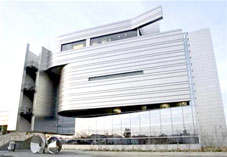Green houses - offices can limit the warming of Earth
The harmonious combination of design and use of energy saving devices in the housing construction sector can play a key role in reducing greenhouse gas emissions, which are considered culprits. mainly warms the Earth's temperature.
UNV Director of the Environment Program (UNEF) Achim Steiner made such a statement in a March 29 report. The rational use of concrete, metal and wood in construction, and reducing power consumption for ventilation, air conditioning and lighting can save billions of dollars in the field. houses and offices - accounting for 30-40% of the world's electricity consumption.

Wayne L. Morse courthouse in Oregon state was issued a gold certificate by the US ' Green ' Council for the use of energy-saving materials and environmentally friendly designs in 2006. (Photo: Reuters)
It is reported that housing and office buildings can play an important role in the fight against climate change, but it is not always necessary to use expensive technical solutions. Simple saving measures such as using sunlight to heat water, using energy-saving light bulbs (compact lamps), rational use of natural ventilation systems and energy-efficient civil appliances also very effective.
The International Energy Agency estimates that if by 2010, the world uses compact bulbs, it will reduce 470 million tons of CO 2 emissions. In addition, it is necessary to avoid construction of buildings that are too large to meet the demand. According to calculations, with simple saving measures, the housing and office area each year can contribute to reducing 1.8 billion tons of CO2, and if more radical measures are taken, it may be reduced. up to 2 billion tons of CO2 emitted into the environment, which is nearly three times the amount of emissions that the Kyoto Protocol intends to cut.
The Kyoto Protocol requires 35 industrialized countries to cut greenhouse gas emissions primarily by reducing fossil fuel consumption in industrial activities, but not providing incentives to build those. The house is environmentally friendly, while the housing and office sector, together with the transport and agriculture sectors, contribute significantly to the generation of CO2.
The UNEF report suggests that developing countries need to focus on building ' green buildings ', because China builds nearly 2 billion square meters of new homes each year. In total, energy used for housing still accounts for the largest share. The report also suggested that to save energy, use of wood materials instead of steel should be strengthened, renovation and renovation of old buildings instead of dams to design and build new houses. The report shows, for example, the European case, if it is determined to adopt new standards for housing construction and renovation of existing houses, these countries could save more than 1/5 of their consumption by 2010. energy compared to today, and reducing up to 45 million tons of CO2 emissions into the environment each year.
- Green 'roof' and war on Earth warming
- The global warming made it harder for aircraft to take off
- The warming Earth makes Antarctica more and more green
- The house is transparent throughout the forest
- Building houses with straw - ideal for the environment, economically efficient
- Cozy: A modular home that simulates a hobbit-style low-rise house
- Earth warms, the Arctic will explode vegetation
- Earth turns slower because of global warming
- Will the world scarcely green vegetables for climate change?
- Dust molecules help limit climate change?
- 7 changes if the Earth gets hotter
- CO2 gas makes the Earth green
 Is the magnetic North Pole shift dangerous to humanity?
Is the magnetic North Pole shift dangerous to humanity? Washington legalizes the recycling of human bodies into fertilizer
Washington legalizes the recycling of human bodies into fertilizer Lightning stone - the mysterious guest
Lightning stone - the mysterious guest Stunned by the mysterious sunset, strange appearance
Stunned by the mysterious sunset, strange appearance